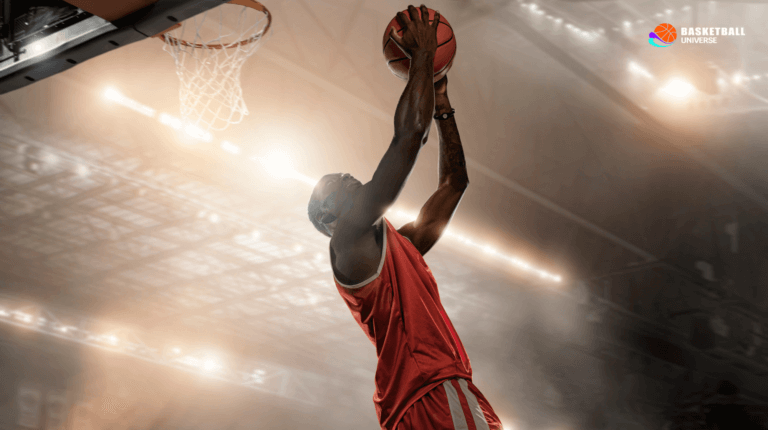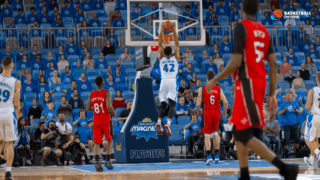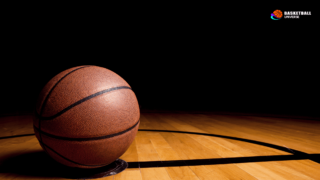
Are Basketball Shoes Good for Running?
Written by: Basketball Universe
Last updated:

In the world of athletic footwear, basketball shoes have long held a special place in the hearts of sports enthusiasts. But as we strive to make the most out of our gear, the question arises: Are basketball shoes good for running? In this blog post, we’ll dive into the unique features and design elements that set basketball shoes apart from running shoes, explore the compatibility of these two different worlds, and determine whether all those high-flying hoop stars could make the leap to the pavement. So, lace up your sneakers, fasten your seat belts, and let’s embark on this exciting, sole-searching journey!
Are Basketball Shoes Good for Running?
While basketball shoes can be used for short or casual running sessions, they are not ideal for long runs or regular running workouts. Basketball shoes are designed with specific features to cater to the demands of the sport, including ankle support, cushioning for shock absorption, and lateral support for quick movements. Running shoes are lightweight, flexible, and optimized for forward motion, providing more arch support and cushioning focused primarily on the heel-to-toe motion. Wearing basketball shoes for long-distance running might result in discomfort, reduced performance, and increased risk of injury.
Designed for Different Purposes
Understanding the difference between basketball shoes and running shoes lies in grasping the unique demands each sport places on the feet. The motions and stress points generated in basketball versus running have led to entirely different design approaches, each tailored to support the athletes during the respective activities. Let’s explore the key differences in design that make basketball shoes less suitable for running.
A Question of Support
When you think of basketball, the first thing that likely comes to mind is players making high-impact jumps and explosive lateral movements. Basketball shoes excel at providing support, particularly around the ankle. High-top footwear, which is prevalent in the sport, helps to prevent injuries caused by awkward landings or sudden, sharp turns. In contrast, running places considerably less strain on the ankle and requires minimal lateral support. As a result, running shoes typically prioritize flexibility and the range of movement for a comfortable, uninhibited stride.
Specialized Cushioning
Another significant aspect that puts basketball shoes at a disadvantage for running is the difference in cushioning. Basketball demands thick and robust cushioning for impact absorption during jumps, landings, and quick stops. Consequently, basketball shoes often have firm, air-based cushioning systems. Running shoes, on the other hand, feature more foam cushioning, emphasizing the heel-to-toe motion. This design choice is essential for efficiency during running, as it ensures a smooth stride and less energy loss.
Understanding the Anatomy of Basketball and Running Shoes
Now that we’ve outlined the fundamental design differences between basketball and running shoes, let’s dive into their specific features, how they work, and the potential concerns that may arise when using basketball shoes for running.
Midsole: The Crux of Cushioning
While the midsole may not be instantly visible, it’s a crucial part of any athletic shoe, as it houses the cushioning system. Both basketball and running shoes share similarities in this region. They should be comfortable, durable, and provide ample shock absorption. However, basketball shoes typically have stiffer midsoles for added stability in lateral movements. Running shoes, on the other hand, feature a more flexible midsole, designed to adapt to your stride, and respond more efficiently to constant forward motion.
Outsole: Traction for Different Surfaces
The outsole is the rubber layer on the bottom of athletic shoes, responsible for providing traction and grip. In basketball shoes, the outsole is designed to offer excellent grip on indoor courts, helping players maintain control during abrupt stops and quick cuts. Conversely, running shoes feature various tread patterns crafted for specific terrains and providing optimal grip on surfaces such as pavement, trails, or tracks. Furthermore, running shoes often include additional flex grooves, offering extra flexibility for a smoother gait cycle.
Upper Material: Breathability and Durability
The upper part of basketball shoes is designed to provide stability, durability, and substantial foot support. These attributes lead to a more durable construction, often with heavier materials like leather or synthetic overlays. However, running shoes focus on airflow, flexibility, and lightweight design. They often incorporate mesh fabrics to allow for superior breathability, wicking away moisture, and keeping the feet cool and dry during long runs.
Heel-to-Toe Drop: The Role of Foot Strike Mechanics
Heel-to-toe drop refers to the difference in the shoe’s cushioning heights in the heel and forefoot. This drop typically affects a runner’s foot strike mechanics. Basketball shoes have a relatively high heel-to-toe drop to provide greater shock absorption during jumps and landings. Running shoes, however, have a more diverse range of heel-to-toe drops designed to cater to various foot-strike patterns. Your ideal running shoe should consider the drop, accounting for personal factors like foot pronation and individual biomechanics.
The Downfalls of Running in Basketball Shoes
With a better understanding of the design nuances between these athletic shoes, let’s examine some points of concern that may arise when using basketball shoes for running purposes.
Weight: Running with Extra Baggage
Weight plays a crucial role in determining one’s performance while running. Running shoes are explicitly engineered to be lightweight and assist runners in long miles without causing fatigue from excess mass. Unfortunately, basketball shoes tend to be heavier due to their more generous padding, thicker outsoles, and resilient materials. Adapting to heavier footwear can result in decreased performance, higher energy expenditure, and may affect your overall running experience.
Discomfort: When Your Feet Are Crying for Help
Owing to stiffer midsoles and heavier construction, basketball shoes may cause discomfort during extended runs. Furthermore, the cushioning in basketball shoes is not optimized for the repetitive heel-to-toe movements during running. Consequently, if you challenge these shoes with longer distances, you may develop blisters, chafing, or abrasions, given their high tops and more rigid structure.
Risk of Injuries: An Unwelcome Trade-off
Using basketball shoes for running might increase the risk of injury due to their design characteristics, including reduced flexibility, different cushioning systems, and a higher heel-to-toe drop. Additionally, basketball shoes do not typically offer enough arch and torsional support, which is crucial for runners. The combination of these ill-suited features can create extra stress on the feet, ankles, and knees, predisposing you to potential running injuries.
Permissible Exceptions and Alternatives
While we’ve established that basketball shoes are less than ideal for running, there are a few acceptable exceptions and alternatives for those seeking versatility in their footwear.
Short Distances: Quick and Easy
If you plan to run just a mile or two occasionally, you can wear basketball shoes without causing significant harm. However, it’s crucial to remain mindful of the potential risks and discomfort associated with this choice. Additionally, refrain from making basketball shoes your go-to option for daily runs or extensive training sessions.
Cross-Training Shoes: A Happy Medium
If you’re looking for a versatile, all-in-one footwear solution, consider investing in cross-training shoes. These shoes are designed to cater to various physical activities, including light running, weightlifting, and sports training. While not specialized for basketball or running, they provide a balanced blend of unique features, making them ideal for those with diverse workout routines.
Conclusion: Choosing Wisely for Your Feet
Given the distinct differences in design and support, basketball shoes are not recommended for regular, long-distance, or high-mileage running. Instead, invest in a pair of running-specific shoes to ensure a comfortable, efficient, and injury-free running experience. Always remember that your feet deserve the best, and choosing the appropriate footwear can have a tremendous impact on your athletic journey.
Selecting the Right Running Shoe
Choosing the correct running shoe is crucial in ensuring an enjoyable and injury-free experience. Here are some essential factors to consider when selecting your perfect pair, tailored to your unique needs, preferences, and running style.
Foot Shape and Pronation
Understanding your foot shape and pronation is vital to finding the right running shoe. Pronation is the natural inward rolling motion of the foot during a running gait cycle. Depending on the degree of pronation, runners can be classified into three categories: neutral, overpronators, or underpronators (supinators). Each category requires specific shoe features for optimal support.
To identify your pronation, take a look at the wear pattern on the soles of your old shoes or have your gait analyzed in a sports equipment store. Armed with this information, you can then select the ideal running shoe suited to your foot mechanics, reducing your risk of injury.
Fit and Comfort
A comfortable fit is non-negotiable when it comes to running shoes. Choose a shoe that feels supportive and secure but allows enough room for some foot expansion during a run. The ideal fit should accommodate your natural foot shape and avoid any tightness, rubbing or constricting feelings. A proper fit will help prevent injuries, blisters, and discomfort, making your entire running experience much more enjoyable.
Running Surface and Terrain
The type of terrain or surface you predominantly run on should dictate your choice of running shoes. For instance, if you primarily run on tracks or pavements, you might consider road running shoes that offer ample cushioning and stability for a smooth ride. Trail runners, on the other hand, may require trail-specific shoes that provide more traction, underfoot protection, and additional support for uneven surfaces.
Shoe Cushioning and Responsiveness
The cushioning in running shoes varies greatly, from minimalistic models to those with ultra-plush padding. Some runners prefer a more “barefoot” running experience with lower cushioning, while others opt for extra padding for additional shock absorption and comfort. Finding the ideal balance between cushioning and responsiveness is a matter of personal preference that can greatly affect one’s running comfort and efficiency.
Proper Care for Your Athletic Shoes
Maintaining your athletic shoes, whether basketball or running, is vital for a long-lasting and comfortable user experience. Here are some tips to ensure that your shoes stay in top shape and provide reliable performance for the long haul.
Clean Shoes Regularly
Wipe away dirt and debris after each use to keep your shoes clean and fresh. For deeper cleaning, follow the manufacturer’s guidelines on shoe care. Generally, this involves washing them by hand or gently scrubbing with mild detergent and a soft brush.
Air Dry Shoes After Use
Moisture can damage the materials and compromise shoe performance. After every use, remove any remaining sweat and moisture by letting your shoes air dry. Avoid exposing them to direct heat sources, such as a radiator, as this can damage the materials.
Rotate Between Different Pairs
If you frequently engage in several sports or undertake multiple workouts a week, consider rotating between two or more pairs of athletic shoes. This practice can extend the lifespan of your shoes and benefit your feet by providing diverse support structures.
Replace Shoes When Necessary
Keeping an eye on wear and tear is essential for maintaining optimum performance and support. Both running and basketball shoes have a limited lifespan, averaging around 300-500 miles for running shoes and up to a year for basketball shoes, depending on usage. As the cushioning and support begin to deteriorate, replacing your shoes is crucial in preventing injury and providing a consistent level of comfort and performance.
Wrap Up: Optimize Your Performance and Comfort
Understanding the design and support differences between basketball shoes and running shoes is crucial in making informed, safe, and efficient footwear choices. By selecting shoes specifically engineered for their respective sports, you can optimize your performance, enhance your comfort, and reduce your risk of injury. Remember, your feet are the foundation of your athletic success, and investing in the right gear is often a game-changer. Happy running!
Frequently Asked Questions
In this FAQ section, we’ll address some common questions that may arise as you navigate the world of athletic footwear, particularly focusing on basketball shoes, running shoes, and their compatibility. Below are our responses to some of the most frequently asked queries, aiming to provide you with additional insights into this essential aspect of sports gear.
1. Can I use running shoes for playing basketball?
While you can use running shoes for playing basketball occasionally, they are not recommended, as they lack the ankle and lateral support necessary for the sport. Using running shoes for basketball may increase the risk of injury, and their cushioning and construction are not optimized for this sport’s high-impact movements.
2. How can I know which running shoes are best for me?
To determine the best running shoes for your needs, consider factors such as your foot shape, pronation, fit and comfort, running surface or terrain, and preferred shoe cushioning and responsiveness. Visiting a specialized store and consulting with an expert can further help you make the right choice for your personal biomechanics and running style.
3. Can I use basketball shoes for other sports?
Using basketball shoes for other sports is generally inadvisable due to their specific support and design features. Basketball shoes are engineered to provide ankle support and optimal cushioning for basketball movements. While they might be suitable for occasional casual use, they may not perform well or be comfortable for other sports.
4. Are high-top sneakers better than low-top sneakers for basketball?
High-top sneakers generally provide more ankle support and stability, making them a popular choice for basketball players. However, low-top sneakers might offer increased flexibility and a lighter feel. Ultimately, it depends on personal preferences, playing style, and history of ankle injuries when selecting between high-top and low-top sneakers for basketball.
5. How often should basketball shoes be replaced?
Basketball shoes should be replaced once they show signs of wear and tear or diminished support and cushioning. The replacement frequency varies depending on usage and shoe quality, but most players replace their basketball shoes every six months to a year.
6. How often should running shoes be replaced?
Running shoes should generally be replaced every 300-500 miles or once they show significant signs of wear and tear, loss of cushioning, or decreased support. Regularly monitoring your shoe condition and tracking your mileage will help you determine when it’s time for a new pair.
7. Can I wash my athletic shoes in a washing machine?
While some shoes are machine washable, others may not be, so check the manufacturer’s care instructions before attempting to wash them in a washing machine. To avoid damaging your shoes, always remove the laces and insoles and place them in a mesh laundry bag before washing. Air dry your shoes afterward, avoiding direct heat sources.
8. Why do running shoes have different heel-to-toe drops?
Running shoes have different heel-to-toe drops to accommodate various foot strike mechanics and personal preferences. Lower drops can promote a more barefoot or midfoot strike, while higher drops generally cater to heel strikers. Your ideal heel-to-toe drop should consider factors such as your running style, foot pronation, and individual biomechanics.
9. How can I determine my foot pronation?
To determine your foot pronation, inspect the wear pattern on the soles of your old shoes or consult with a specialist at a sports equipment store to assess your gait. Understanding your pronation will help you make informed decisions when selecting the most suitable running shoes for your unique needs.
10. Can I use the same pair of shoes for both running and gym workouts?
While some people do use the same pair of shoes for both activities, it is generally better to have separate shoes for running and gym workouts. Running shoes are designed for forward motion and may not provide adequate support during lateral movements, while cross-training or gym-specific shoes offer a more balanced blend of stability, cushioning, and support for varied activities.
11. Are minimalist running shoes better than traditional shoes?
Whether minimalist running shoes are better than traditional shoes is subjective and depends on individual running styles, foot mechanics, and personal preferences. Minimalist shoes have less cushioning to promote a more barefoot running experience but may not suit runners who require more support. It’s crucial to make an informed decision that considers your specific needs and biomechanics.
12. How can I prolong the lifespan of my athletic shoes?
To prolong the lifespan of your athletic shoes, practice proper care, such as regularly cleaning and air drying them, rotating between different pairs, and replacing them when necessary. Additionally, avoid using your shoes for unintended purposes, as this can contribute to increased wear and tear.
13. Is it normal for my feet to hurt after switching to a new pair of athletic shoes?
Some minor discomfort may be expected as your feet adapt to a new pair of shoes, especially if they have a different support or cushioning system. However, if the pain is severe or persists for an extended period, it’s possible that the shoes may not be suitable for your feet or are not correctly fitted. In this case, consider consulting a professional or trying different shoes.
Featured Posts
- No pillar pages found.





